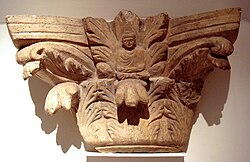Corinthian order
The corinthian order is one of the three main classical orders (styles) of ancient Greek and Roman architecture. The other two are the Doric order and Ionic order.
The Corinthian is the most decorative of the three orders. It has thin columns that have grooves running vertically up the sides. The most important difference with the other orders is the big capital (top part of the column), which is decorated with leaves and scrolls.
History
The oldest known example of a Corinthian column is in the Temple of Apollo Epicurius at Bassae in Arcadia, ca 450–420 BC. This column stands inside the temple and does not form part of the wall. The oldest use of the Corinthian order on the outside of a structure is the round Choragic Monument of Lysicrates in Athens. It was put in place around 334 BC.
Examples of Corinthian order architecture
- Greece
- Rome
- Pantheon, Rome (illustration)
- Temple of Mars Ultor
- Renaissance and Baroque
- Neoclassical and Beaux-Arts
- United States Capitol (illustration)
- St. La Salle Hall, Manila
- Don Enrique T. Yuchengco Hall, Manila
- Enrique M. Razon Sports Center, Manila
- Ukraine
- Great Lavra Belltower (fourth tier - 8 columns)
- Germany
- The Reichstag, Berlin
Corinthian Order Media
Corinthian peripteros of the Temple of Bacchus, Baalbek, Lebanon, unknown architect, 150–250
Corinthian columns from the Pantheon, Rome, unknown architect, c. 114–124 AD, which provided a prominent model for Renaissance and later architects
Frieze and capitals of the Choragic Monument of Lysicrates, Athens, unknown architect, 330s BC, one of the earliest surviving examples
Bucrania with festoons decorating the Temple of Vesta from Hadrian's Villa, Tivoli
Corinthian columns of the Arch of Septimius Severus, in the Forum Romanum
Corinthian columns of the Arch of Septimius Severus in Leptis Magna
Figure of the Buddha, within a Corinthian capital from Gandhara, Musee Guimet, Paris, unknown architect, 3rd–4th century
Vincenzo Scamozzi offers his version of the Corinthian capital, in a portrait by Veronese (Denver Art Museum)
Ancient Greek capital from Tarentum with addorsed sphinxes, 4th–3rd centuries BC, made of limestone, in the Metropolitan Museum of Art, New York City
Related pages
Other websites
| Wikimedia Commons has media related to Lua error in Module:Commons_link at line 62: attempt to index field 'wikibase' (a nil value).. |










